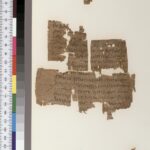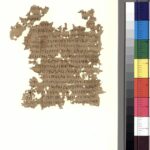| Artefact ID | 645 |
| TM ID | TM 61827 |
| Findspot (DEChriM ID) | - () | Class | Textual |
| Material | Papyrus |
| Writing medium | Codex |
| Text content | Literary |
| Language | Greek |
| Description | Gregory-Aland P53; 𝔓53; NT53 Papyrus fragments from a codex containing the Matt. 26:29-40 and Acts 9:33-10:1. The fragments are comprised of two folios: Folio A contains parts of the second Gospel of Matthew, and measures 11.5 x 10.3 cm. The verso preserves 20 lines, and the recto 19 lines: the verso precedes the recto. Folio B contains parts from the Acts of the Apostles. The folio is comprised of several smaller fragments: 3 fragmens constitute the larger part of the folio, measuring 9.5 x 12 cm, and a smaller, separate fragment measures 1.3 x 1.5 cm. The folio preserves 17 lines on the verso, and 16 on the recto: the verso precedes the recto. This sequence implies that the folios were part of the first half of a quire; see ed. pr. The codex is assumed to have contained the four Gospels and the Acts (or Matthew and the Acts), and is estimated to have measured 22 x 12 cm with approx. 25 lines of text per page; see Comfort / Barett 1999: 359-363. The hand is described by the ed. pr. as a semi-cursive with considerable linking between letters. The text does not make use of any punctuation, only a few 'dots are visible, however, the ed. pr. doubts that they were made by the first hand or that they are even made in ink. There occur several nomina sacra and two apostrophes (l. 15 and 18 of the recto on fr. A (Matt.)). A correction has been made by a second hand (probably contemporary) in l. 12 on the recto of fr. A. |
| Selection criteria | Literary genre (Biblical) |
| Date from | 350 |
| Date to | 399 |
| Dating criteria | Palaeography. Dated by the ed. pr. to the middle of the 3rd c. The fragment was later placed in the second half of the 4th c. by W. Clarysse and P. Orsini; see Clarysse / Orsini (2012): 470. |
| Absolute/relative date | Relative date |
| Archaeological context | Provenance is unknown. The Arsinoites (Fayûm) has been suggested as the provenance because of the accession history, considering that the fragments were purchased from the antiquities dealer Maurice Nahman (Cairo) through H.I. Bell in 1934; see ed. pr. |
| Accession number | Ann Arbor, Michigan University, Library P. 6652 + 6679 |
ARTEFACT IDENTIFIERS
Editio princeps:
∙ Sanders, Henry A. 1937. "A Third Century Papyrus of Matthew and Acts". Quantulacumque; studies presented to Kirsopp Lake by pupils, colleagues and friends. Lake, Kirsopp, Robert Pierce Casey, Silva Lake, and Agnes Kirsopp Lake, eds. London: Christophers. 151-161.
Additional bibliography:
∙ Aland, Kurt. 1976. Repertorium der griechischen christlichen Papyri: 1. Biblische Papyri: Altes Testament, Neues Testament, Varia, Apokryphen. Neues Testament 53.
∙ Charlesworth, S.D. 2016. Early Christian Gospels: Their Production and Transmission. Pap. Flor. 47. Forence. Plate no. 12.
∙ Clark, K. W. 1937. A Descriptive Catalogue of Greek New Testament Manuscripts in America. Univ. of Chicago Press. 340.
∙ Clarysse, Willy and Pasquale Orsini. 2012. "Early new testament manuscripts and their dates: A critique of theological palaeography". Ephemerides Theologicae Lovanienses 88. 443-474.
∙ Comfort, Philip W. and David P. Barrett. 1999. The complete text of the earliest New Testament manuscripts. Grand Rapids, Michigan. 359-363.
∙ Jaroš, Karl. 2006. Das Neue Testament nach den ältesten griechischen Handschriften (CD-Rom). Wien-Würzburg: Echter. 3769-3792, no. 2.8.
∙ Head, P. M. 1990. "Observations on Early Papyri of the Synoptic Gospels, especially on the 'Scribal Habits'". Biblica: Commentarii Periodici Pontificii Institutii Biblici 71. 240–247.
∙ Min, Kyoung Shik. 2005. Die früheste Überlieferung des Matthäusevangeliums (bis zum 3./4. Jh.). Berlin, Boston: De Gruyter. 153.
∙ van Haelst, Joseph. 1976. Catalogue des papyrus littéraires juifs et chrétiens. Paris. Description no. 380.


 Json data
Json data





